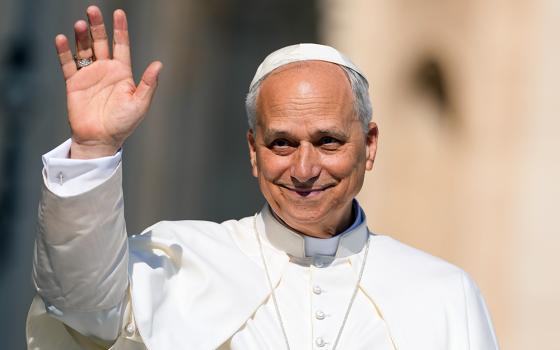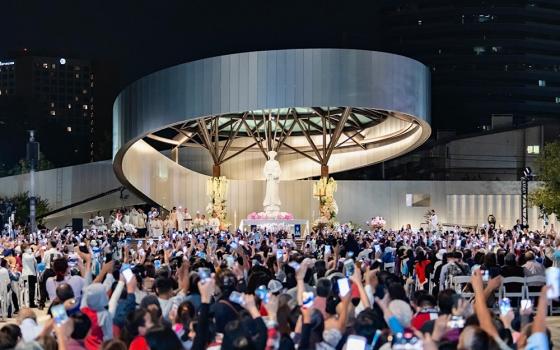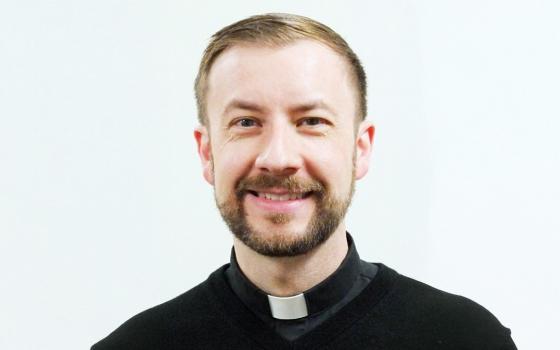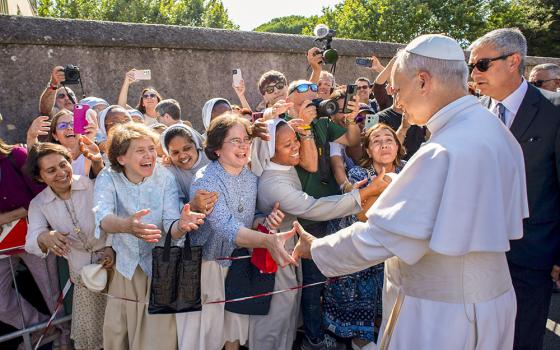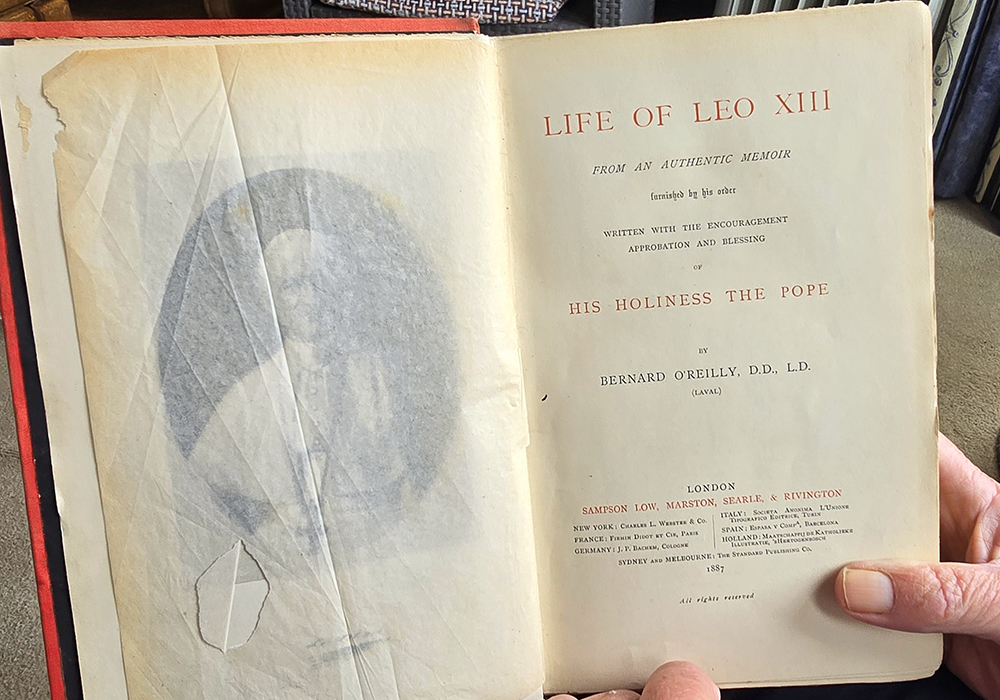
Life of Leo XIII: From an Authentic Memoir Furnished by His Order, by Irish Fr. Bernard O'Reilly, is "a papal biography based on a manuscript provided by Pope Leo XIII himself," says John Cooney, retired journalist. (Sarah Mac Donald)
Gathering dust for many years on a bookshelf in a Dublin home was a rare first edition of the life of Pope Leo XIII dating from 1887. In the wake of Pope Leo XIV's election in May, John Cooney was spurred to take down that distinctive red book from his bookshelf, blow off the cobwebs that had gathered over decades, and delve into the life of the new pope's predecessor and namesake — Leo XIII.
A veteran religious affairs correspondent, Cooney picked the book up over 40 years ago at a flea market in Brussels. Life of Leo XIII: From an Authentic Memoir Furnished by His Order "is a papal biography based on a manuscript provided by Pope Leo XIII himself.
Technically, it's a papal autobiography," Cooney explained. The book carries the subtitle: Written With the Encouragement, Approbation and Blessing of His Holiness the Pope.
It was written by papal confidante Fr. Bernard O'Reilly, an Irish priest from County Mayo. "O'Reilly writes from the inside. This isn't secondhand history. He had the pope's manuscript. That's incredibly rare," Cooney told NCR.
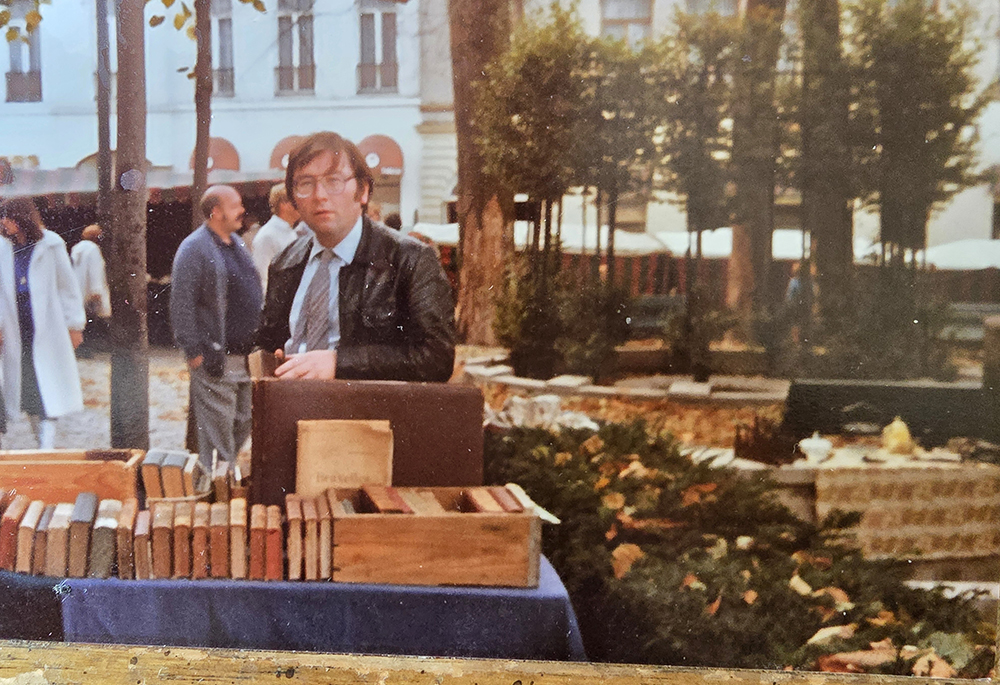
The book stall in Brussels, Belgium, where John Cooney bought the 1887 edition of the biography in 1981 when he was living and working there as a correspondent for The Irish Times. (Courtesy of John Cooney)
O'Reilly emigrated to Canada as a youth and joined the Jesuits there in 1843. Later he served as a military chaplain in the American Civil War before he went to work in the Vatican. Cooney has learned that an American company is planning to republish the book in light of the interest Pope Leo XIV has generated in Leo XIII. Previous editions of the book can be purchased online.
"Leo handed the manuscript to O'Reilly, who was his private secretary. He wrote it while Leo was still alive, with his blessing. That elevates this book to practically an autobiography," Cooney said.
Born Gioacchino Pecci on March 2, 1810, the future Leo XIII was elected pope on Feb. 20, 1878, and his papacy continued until his death on July 20, 1903, making it one of the longest of any pope in history.
Leo XIII is remembered for his 1891 encyclical Rerum Novarum, in which he advocated for workers' right to a fair wage, just working conditions and the formation of trade unions. Pecci had a stellar diplomatic career prior to his elevation to the See of Peter. In 1843, at just about 33, the then-Bishop Pecci was appointed apostolic nuncio to Belgium. The biography, according to Cooney, is filled with insights not just into Leo's papacy, but his diplomatic service as well.
"Pecci was a young highflier under Pius IX," Cooney said. "This book captures that journey, as nuncio and later as he rose in the Curia."
As a Scot who is proud of his Catholicism, Cooney has always been interested in Leo XIII as the pontiff who re-established the Scottish hierarchy on March 4, 1878. This ended Scotland's classification as a missionary country following the church's suppression in the wake of the Reformation. Leo XIII's restoration saw six dioceses and two archdioceses established in Scotland. To this day the Scottish hierarchy remains separate to that of England and Wales.
Cooney bought the book at a stall in Brussels in 1981 when he was living there, working as the European Economic Community (forerunner to the European Union) correspondent for The Irish Times. "The red-colored book caught my eye; it resembled the pre-Vatican II missal used by priests when I was an altar boy in St. Joseph's Church, Blantyre, Scotland."
Cooney has a photograph of the exact moment in August 1981 when he purchased this original 1887 edition which bears Leo XIII's coat of arms and contains photos of the pontiff as well as testimonials from other church dignitaries. For Cooney, this wasn't just about a rare book.
"I was intrigued about the book's provenance. A forgotten Irish American from Mayo gravitating back to Europe in adult life as a learned doctor of divinity and a canon lawyer who becomes a trusted friend and confidante of Pope Leo XIII and part of the papal inner court." Cooney also likes the "symmetry" of the Brussels connection, where then-Archbishop Pecci served as papal nuncio in the 1830s, and "where I uncovered his biography 150 years later."
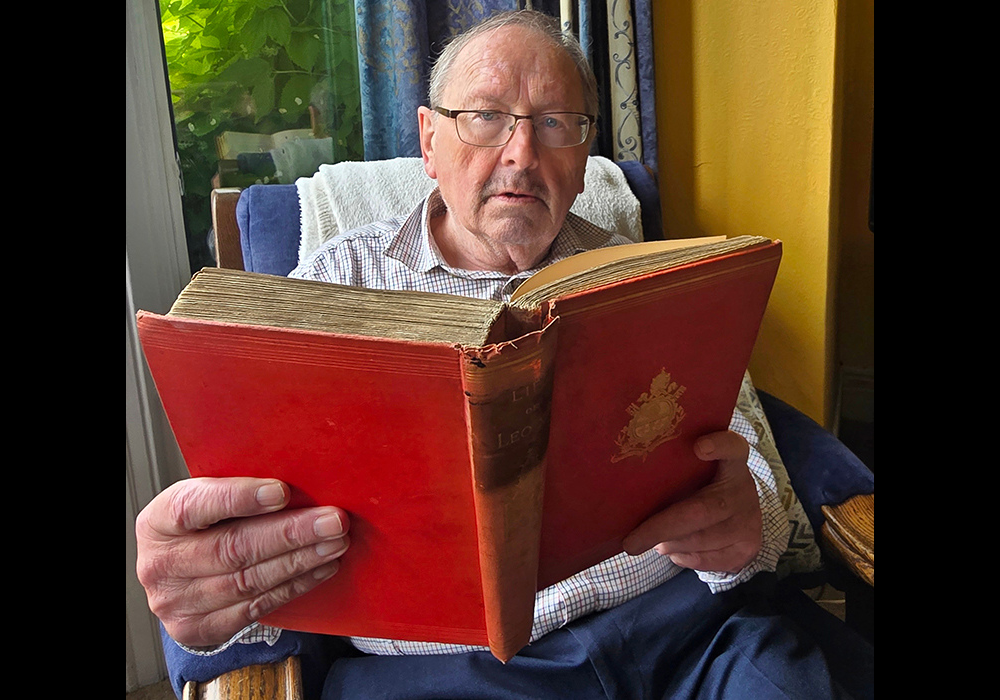
John Cooney, retired religious affairs correspondent with The Irish Times and Irish Independent, at his home in Dublin, Ireland, with his first edition, dating from 1887, of Life of Leo XIII: From an Authentic Memoir Furnished by His Order. (Sarah Mac Donald)
Born and raised in Blantyre, Cooney was steeped in working-class Scottish Catholic culture. As well as being an altar boy, he was also in the Legion of Mary.
"My dad was a shop steward and was active in the St. Vincent de Paul [Society]," he said. After school, he studied history at Glasgow University. "I was drawn to 19th-century Irish nationalism — people like [Charles Stewart] Parnell and [Michael] Davitt. I wanted to explore the interplay between faith, politics and class."
Cooney was mulling whether to continue his history studies or join the Labour Party with a view to a political career when he got the Sir Godfrey Collins traveling scholarship which was worth 500 British pounds. It enabled him to go to Paris and interview some of the top religious affairs correspondents who covered the Second Vatican Council, people like Henri Fesquet, the religious affairs correspondent for Le Monde and Alain Woodrow of Les Informations Catholiques Internationales, who signed Cooney up as Scottish correspondent for the French periodical. He had already begun to report on Sunday chaplaincy talks at university by high-profile Catholics for the Scottish Catholic Observer.
Advertisement
"The Scottish scholarship was huge in the early 1970s and enabled me to travel not just to Paris, but also to Vienna and Rome where I made my debut at the 1971 Synod of Bishops. There I met John Horgan, the religious affairs correspondent of The Irish Times. At the end of the synod, he told me he was moving to another job and that if I was interested, he would recommend me as his successor."
Back in Scotland, he was quickly propelled into the journalistic arena. At the Glasgow Herald, he broke the story of the dismissal of Jesuit Fr. Gerard Hughes as chaplain to Glasgow University by the Archbishop of Glasgow over his open letter criticizing Pope Paul VI's controversial 1968 encyclical, Humanae Vitae. The decision was later reversed following public uproar. "Peter Hebblethwaite, a Jesuit commentator, told me it was the first time in Britain a bishop reversed a decision because of media pressure," Cooney said. (The late Hebblethwaite was a former NCR Vatican correspondent.)
By 1972, Cooney had joined The Irish Times as religious affairs correspondent and his first day on the job saw a front-page scoop which was illustrated by the iconic image of Irish President Eamon de Valera kissing the ring of Dublin Archbishop Dermot Ryan. Despite the auspicious start, it wasn't all plain sailing as clerical feathers were ruffled.
"Archbishop Ryan — a real snob — didn't like my long hair or that I didn't have a theology degree. He lobbied The Irish Times to sack me." The paper reassigned him to Brussels as EEC correspondent. "That's how I found the book."
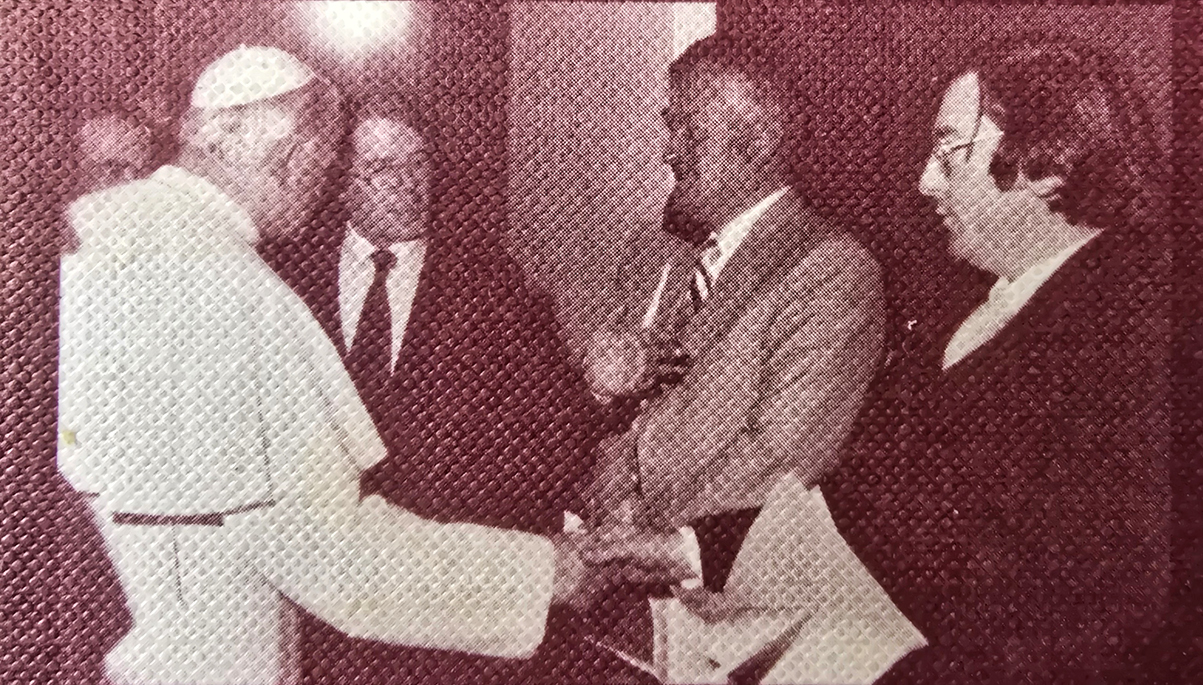
John Cooney meets Pope John Paul II. This photo is published on the back of Cooney's book, Scotland and the Papacy, his assessment of Scottish Catholicism. (Sarah Mac Donald)
But it was the book's author, O'Reilly, who would become the focus of Cooney's historical curiosity.
"I had never heard of him before. I thought he must be Irish and then I discovered he had emigrated as a boy from Mayo and landed in Quebec." There, O'Reilly flourished academically, enrolling at Laval University. He later earned a doctorate in divinity, but he was also involved in a practical pastoral work with impoverished Irish immigrants who arrived in the wake of the Irish Famine (1845-1849), including those quarantined in typhus sheds along the St. Lawrence River. Cooney sees a correlation between his own travels and O'Reilly's and the St. Lawrence River "which was notorious as the graveyard of thousands of Irish migrants."
He believes he may have retraced some of O'Reilly's steps across North America in 1982 on a U.S. State Department young European traveling scholarship courtesy of the U.S. embassy in Brussels. The bursary provided him with a month's travel enabling him to interview eminent Americans involved in politics and civil society.
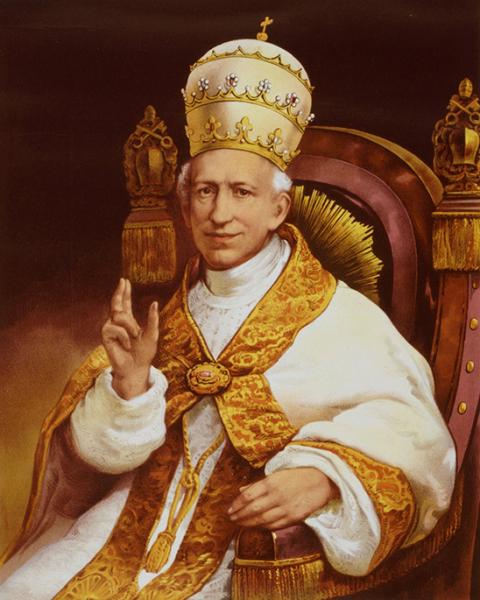
Pope Leo XIII is depicted in this official Vatican portrait. (OSV News/Library of Congress)
"It took me coast to coast. My sister Mary was at Harvard University at the time with her then fiancé [who became her husband], Martin Sixsmith [the BBC journalist who wrote The Lost Child of Philomena Lee about Irish mother and baby homes run by Catholic orders]. Mary and Martin, Liguori [Cooney's wife] and I hired a car and went up to Newfoundland, and then to Quebec and back to New York, before I returned to Brussels."
O'Reilly was attached to St. John's College, now Fordham University, in New York when the American Civil War erupted. He served as a chaplain in the Irish Brigade and with the Army of the Potomac.
"He joined the Union Army and was at the Battle of Antietam [Sept. 17, 1862], one of the bloodiest battles in American history. That tells you a lot about his courage and his commitment," Cooney said. After the war, O'Reilly travelled to Rome and through a mixture of intellectual distinction and charm, gained access to Pope Leo XIII's inner circle. "He was more than a secretary; he became Leo's confidante," Cooney said, adding that he wonders if O'Reilly fostered Leo XIII's strong sympathies with the Irish.
O'Reilly published a number of other books during his lifetime including: Life of Pius IX (1877); Mirror of True Womanhood (1876); True Men (1878); Key of Heaven (1878); The Two Brides (1879); and Life of John MacHale, Archbishop of Tuam (1890). He returned to New York before his death in 1907 and served as chaplain at the convent of Mount St. Vincent.
Cooney believes his Leo XIII publication may be one of the earliest firsthand papal biographies.
"Unlike Pope Francis' autobiography, Hope, this one has depth, detail and intimacy. It offers not just a window into a pope, but a glimpse of 19th-century Catholicism, the Irish diaspora and the global church."
For Cooney, its fascination is more than bibliophilic.
"I didn't go looking for that book," Cooney said. "It found me. This isn't just about Leo XIII. It's also about a forgotten papal confidante, Fr. Bernard O'Reilly. He moved across worlds and he understood the power of words and proximity to power."

